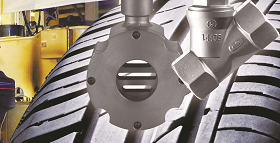

Production plants for tyres place extremely high demands on valves. Tyre curing presses work at high pressures of steam, water, and nitrogen, as well as at high temperatures. In addition, the very short processing cycles require extremely robust valves for very high cycles, so that good operating efficiency is achieved with the service life being as long as possible. In the Continental plant in Púchov, Slovakia, angle seat valves and sliding gate valves from Schubert & Salzer Control Systems have proven particularly suitable for these operating conditions.
Continental, a leading tyre manufacturer with global production facilities, has used Schubert & Salzer valves for years at its plant in Púchov. Previously, a large number of different valves from various manufacturers had been used in the curing installations at this site. This led to increasingly bigger problems in terms of maintenance and spare parts procurement. Some years ago these systems began to be retrofitted uniformly to Schubert & Salzer technology, in order to, above all to optimise the control accuracy, extend the service life under the harsh operating conditions, simplify the maintenance, reduce the range of models, and reduce the processing heat waste.
Space-saving valve construction
Initially, angle seat valves of Type 7010 were used in a special high-temperature design with threaded connections. The special advantage of 7010 angle seat valves is the high wear resistance. Due to the rapid wear of the seating seal, the ball valves, previously used for this purpose, regularly led to leakage and required maintenance after one to two months. The construction of the 7010 angle seat valves allows self-cleaning of the valve seat. This is very important under the critical conditions of vulcanisation with deposits and corrosion in the pipeline. The 7010 valves from Schubert & Salzer have operated at the same place without problems for years.
Relative to other seat valves, angle seat valves save space due to their angled design to the pipeline and the very compact actuators. Compared with traditional globe valves, angle seat valves have high Kvs values with relatively small dimensions. These dimensions make handling of the valve easier and result in a reduced weight for the entire valve.
This construction can be easily insulated, which significantly reduces the heat losses at the valve. With the single acting actuators used here, the number of control air supply lines is also reduced, and the safety of the press systems is increased in the event of the loss of control or power.
After the good experiences with the angle seat valves, Continental also decided to convert the curing installations from hot water to steam based on Schubert & Salzer technology. Instead of an inlet pressure of 3 bar, the valves must now also be able to handle 17 bar. Sliding gate valves are best suited for this purpose, because they can be used simultaneously in both areas of application.
Less wear in all operating situations
The heart of the sliding gate valve is composed of two slotted discs that slide one on top of the other and are sealed relative to each other. A sealing plate fixed in the housing perpendicular to the direction of flow has a defined number of transverse slots of the same size. A rotationally fixed disc with the same arrangement of slots is moved vertically and thus changes the flow cross-section. The subsequent pressure difference presses the moving disc onto the fixed disc. The sliding gate valve thus forms a seal without any metallic seat. This functional principle also causes a self-lapping action of the moving sealing disc. This area seal is thus considerably less susceptible to faults than a ring seal typically used in globe valves. This design achieves leakage rates of less than 0,0001% of the Kvs value.
For a good long-term sealing, there is another system-dependent advantage of sliding gate valves that has an effect on an economical service life. The maximum control stroke of the sliding gate valve is only 9 mm. This short stroke length provides not only short actuation paths and switching times, but the packing and actuators are also operated very gently due to the short stroke length. In the case of sliding gate valves, both are subject to significantly less stress, so that these also have considerably longer service lives.
In the event of maintenance, all common valves require the disassembly of the entire valve housing, in order to reach the seating elements. And this requires, by experience, the help of at least two workers. This is not the case for sliding gate valves. The throttling element can be disassembled and serviced by a single person on site in the plant. After disassembly of the valve, only four cover screws have to be loosened and then the so-called functional unit can be pressed out and replaced.
In curing installations, the following properties of sliding gate control valves have proven extremely advantageous:
• According to operating requirements, the valve can be optimised with a corresponding Kvs value by simple replacement of the fixed disc.
• The high control accuracy of the sliding gate valve allows a shortening of the press cycles resulting in increased productivity.
• Simple and quick maintenance of the valve by replacing the easily accessible disc pair.
For these reasons, all of the valves in this plant have been standardised to Schubert & Salzer. Currently, over 1700 angle seat valves of Type 7010 and approximately 800 control valves of Type 7020 and sliding gate valves of Type 8043 are in use at this plant. Schubert & Salzer valves offer excellent advantages for Continental especially in the areas of cost minimisation for plant management, maintenance, and service.
For more information contact Kamil Maharaj, Macsteel Fluid Control, +27 31 581 7800, [email protected], www.macsteel.co.za
| Tel: | +27 11 383 4000 |
| Email: | [email protected] |
| www: | www.macsteel.co.za |
| Articles: | More information and articles about Macsteel Service Centres |
© Technews Publishing (Pty) Ltd | All Rights Reserved